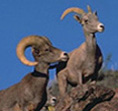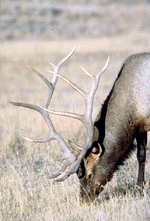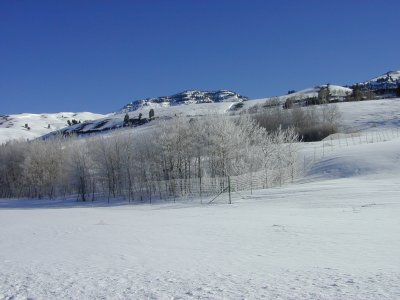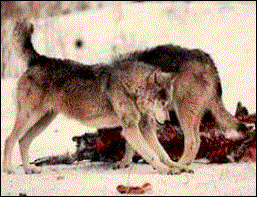|
DIMENSIONS: ecosystem |
Ecosystem Dimension of Elk Management in YellowstoneUngulate Community Dynamics: Yellowstone National Park"Sometimes referred to as America's Serengeti because of the large herds of wildlife that graze on its rolling expanse."
Six species of ungulates are currently found in Yellowstone National Park. Archaeological study has shown that bighorn sheep, bison, pronghorn and deer (both mule and white tail) have coexisted with elk for millennia in the Yellowstone River Valley. Species and winter population estimates (1978) in the Northern Range include:
Elk are by far the most abundant ungulate in Yellowstone. Over time, human harvest has greatly reduced mule deer, bighorn sheep and pronghorn numbers (mid-1870-1880's). Since then, mule deer numbers have recovered, however bighorn sheep are not as numerous as they once were in the Yellowstone area. Houston (1982) reviewed the dynamics of the five less abundant species were reviewed with an emphasis on: resource division, relationships among species, and the effects of elk upon other species. Resource Division: To at least some extent, all six species of ungulates are seasonally migratory. The most important aspect of resource partitioning occurs during the winter months, when snow levels limit food sources.
The effects of elk on other species: Even though resource partitioning does occur, allowing different species to exploit different resources, the large numbers of elk may still impact the abundance of other ungulate species. Elk do overlap in distribution and food habits with other species, which may be affecting those species in a negative way. It is important to remember that relationships between ungulate species are not constant, and changes in climate, fire and succession may reflect changes in interspecific partitioning and/ or competition. Grazing Pressure: Yellowstone National Park, and the Greater Yellowstone Ecosystem
How is grazing pressure created? Elk in Yellowstone graze and browse. That is, they eat primarily grasses and forbs. As the elk population increases in size, grazing pressure on Yellowstone rangeland also increases. The elk population in Yellowstone is large, and has increased in the Greater Yellowstone Ecosystem by a factor of 2.5 from 1968-1988. In 1987-88, approximately 31,000 elk summered and 20,000 elk wintered within Yellowstone National Park. Forage demands for elk must be met in the summer as well as winter months. This presents a problem. Less land is available to elk during winter months where snow covers food resources. The consequence is increased elk density over less land area, which increases grazing pressure on rangelands. Is winter range limited? Available winter range has been reduced by urban development, agriculture, and ranching in the Greater Yellowstone Ecosystem. Efforts have been made to reclaim historic elk winter rangeland. The Rocky Mountain Elk foundation, an independent conservation organization, has been influential in efforts to acquire elk winter range. The National Refuge System (USFW) acquired 25,000 acres of historic winter rangeland for the National Elk Refuge in Jackson, Wyoming. This is ¼ of the historic elk winter range in the Jackson valley. Although land acquisition efforts have achieved some level of success, many critics contend that elk herds which summer in Yellowstone National Park are winter range limited. Where elk have less access to winter range, grazing pressure may reach levels higher than historically attained. How do high levels of grazing pressure affect range condition? High levels of grazing pressure reduce the standing crop of vegetation, can alter plant composition and presence, increase soil compaction and ultimately lead to habitat degradation. The concept of "overgrazing" is defined as an excess of herbivory that leads to degradation of plant and soil resources. The resource management strategy one is employing will qualify what level of herbivory is in excess. If land is being used for ranching, the management goal would be to keep range condition at a level that sustains maximum population yield over time. This would require less grazing pressure. On the other hand, where land is being managed to maintain ecological processes, grazing pressure is expected to be high and "overgrazing" is no longer a valid concept. Where natural regulation, or maintenance of ecological process, is the management objective, as it is in Yellowstone National Park, the entire ecosystem must be intact. The Greater Yellowstone Ecosystem is not fully intact, because accessibility to and availability of historic winter range has been altered. Are there signs of high grazing pressure in Yellowstone? The issue of habitat alteration caused by high grazing pressure, or "overgrazing", is controversial. Various investigators and authors view cause-effect relationships of habitat alteration in Yellowstone differently.
Quotes from cited professionals:
"To me, the point is the ecosystem. Is the system functioning, or are things breaking down? Are we getting an invasion of unpalatable plants, or breaking down soils so that their rate of nutrient recycling is going to pot? That's what I'm looking at. And I don't see that in Yellowstone. Therefore, as a grazing system, this is a healthy one." ¾ 1995 interview with Sam McNaughton, botany professor at Syracuse University, taken from Yellowstone's Northern Range Newsletter. "For many Americans the illusion of the park as a primitive ecosystem was too attractive to be denied. 'Natural' according to a recent report on marketing, by the 1970's had become the most popular word in America, preferred even to 'new' and 'improved'. Natural regulation was a triumph in packaging." ¾ Austin Chase, Playing God in Yellowstone: The Destruction of America's First National Park, 1987. Wolves and Elk in Yellowstone |
|
|
· Roads can affect the elk within the Yellowstone National Park area. There are five park entrances, 466 miles of roads and 1000 miles of backcountry trails, which all effect elk in their migratory patterns and foraging ability. The total number of vehicles on the roads in July of 1999 was 398,680, and in January 2000 were 62,815. The number of vehicles deters the elk from coming in contact with certain areas of the park. Roads increase sedimentation in streams and waterways leading to a decline in water quality. Motorists can kill elk crossing roads. Elk also have smaller habitats to occupy because of motorist’s disturbance. When elk use the roads during winter months for easier traveling, they run the risk of getting hit by cars. Elk crossing the highways often lose group members; thus spending extra energy trying to locate lost members during migration. The above is a diagram of the main roads located in Yellowstone National Park. |
 Elk mortality on the edge of human settlement. |
· Human settlement has an impact on the elk population, densities and migratory patterns. 3000 to 4000 elk spend the summer in the southern areas of the park then migrate to northern Yellowstone National Park for better feeding grounds. Migration North occurs to increase the quality of forage and decrease the energy spent on finding food. Humans have taken up residence in the winter range of the elk for agriculture or developments. Human settlement has lowered the quality of forage and increased competition with livestock. In response, elk have changed migration routes to avoid humans. |
 An example of an ungulate- snowmobile interaction. |
· Winter activities have flourished in the Yellowstone National Park area. One form of winter recreation in particular is snowmobiling. With snowmobiles, people are able to go places not possible before. When snowmobile activity increased, elk population counts lowered in those areas, decreasing habitat availability. Compacted snowmobile trails offer a slight benefit to elk by lowering energy use during migration or foraging. |
 Elk foraging along a riverside. |
· Water quality has become a major issue within the park because of human disturbance. Road building increases the level of sediment input to stream and river systems. Human settlement leads to a reduction in available clean water and increases in waste. Agriculture and industrial water uses have also increased. Hydro-development and pollution from mining, herbicide, and pesticide use from timber and crop production negatively affect water quality. All of these circumstances impact habitat that elk use. |
Links:
http://www.yellowstone-park.net/photo-gallery/display/display-90754792-MVC-013F.JPG-medium.htm
www.nps.gov/yell/technical/gis/browsegraphics/roads.htm
www.nps.gov/yell/stateofthepark.htm




